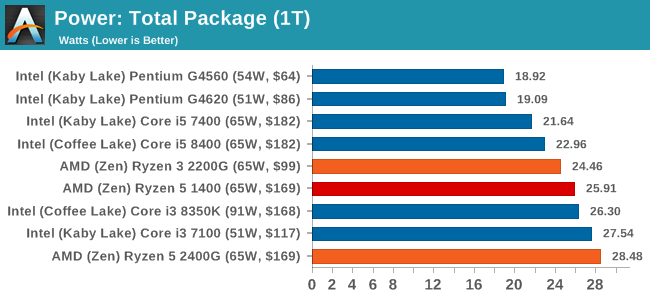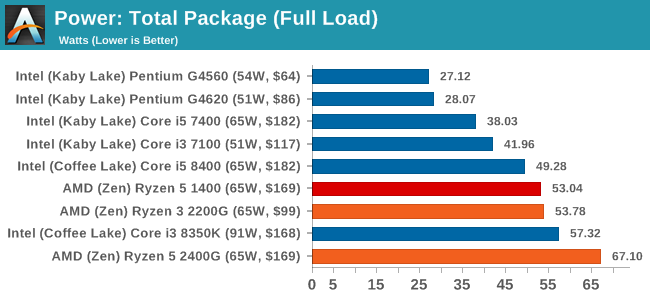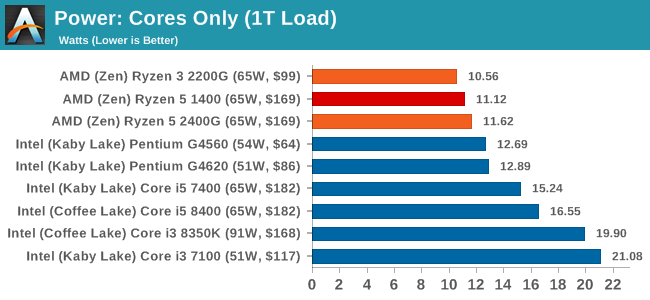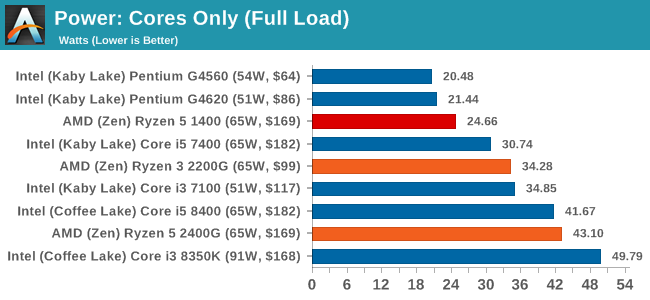Marrying Vega and Zen: The AMD Ryzen 5 2400G Review
by Ian Cutress on February 12, 2018 9:00 AM ESTPower Consumption
For our power consumption metrics, we use a Prime 95 blend on fixed threads to generate a strong load, and then poll the internal power registers that determine power state calculations to get the power consumption. Each processor is different in how it reports its power, which depends on the level of control the processor has: some of the more advanced CPUs, such as Ryzen, will provide per-core power numbers, while the latest Intel CPUs only give a figure for the CPUs as a whole but also include DRAM controller and uncore power consumption.
An interesting element to the power consumption on the Ryzen APUs, due to the unified power delivery subsystem in play feeding the CPU and the integrated graphics, is that the power registers only report half the power consumption when probed (e.g. when 14W, shows 7W). As of yet, we are unsure if this has a knock-on effect on how the processor adjusts its turbo modes in response to power consumption. Nonetheless, a simple scaling factor gives the following results.
Total Package: The Whole Processor
For this data, we take the values of the processor as a whole, which includes all the interconnect, memory controllers, PCIe root complexes, etc. The system is still only loading the CPU cores with minimal effect on the rest of the system, however depending on how the power is managed, some of the sub-systems still remain enabled.


At full load, the difference between the Ryzen 5 and the other Ryzen CPUs shows that the 2400G is using more of its upper margin, compared to the 1400 which is rated at the same power (note TDP is only determined at the base frequency), but the extra frequency of the 2400G means that there is extra power draw overall. Part of this is due to the Infinity Fabric, which we will see below. But what these tests also underline is that in a quad-core configuration, the Intel CPUs are still very power efficient.
Cores Only: Pure Work
For the processors that split out the data, we can look at the power consumption of the cores on their own, without any of the sub-systems, like uncore, mesh, or infinity fabric. This usually paints a different picture to the package power.


For the core only power, the Ryzen 5 2400G uses less power than the Core i3-8350K, despite the situation being reversed when considering the whole package. This means that Infinity Fabric takes a lot of power here, and the ring bus solution that Intel uses benefits from being simpler, and Intel can push more power to its individual cores.










177 Comments
View All Comments
Lolimaster - Monday, February 12, 2018 - link
You don't another model, just disable high clocked pstates till you get the power consumption you want.I can lock my Athlon II X4 to 800Mhz if I desire.
Lolimaster - Monday, February 12, 2018 - link
You can simply set pstate for a lower base clock and also undervolt if you want to reduce power consupmtion even more.Or the lazy way, cTDP in bios to 45w.
Manch - Tuesday, February 13, 2018 - link
Ask and ye shall receivehttps://www.anandtech.com/show/12428/amd-readies-r...
Cryio - Monday, February 12, 2018 - link
This review kind of confused me?It mentioned it's going to compare the A12 9800, but this APU is nowhere to be seen in benchmarks.
Then out of nowhere come A10 7870K, which is fine I guess, but then there's the A10 8750, which doesn't exit, I can asume it's 7850, yet a 7850 non K APU doesn't exist, so what's happening here?
Simon_Says - Monday, February 12, 2018 - link
Will there be any analysis on current and potential future HTPC performance? While it won't support Netflix 4k or UHDBR (yet, thanks Playready 3.0) I for one would still like to know how it handles HDR for local media playback and Youtube, and if it will have the CPU grunt to software decode AV1.Drazick - Monday, February 12, 2018 - link
Does the Ryzen have any hardware based unit for Video trans coding?Could you test that as well (Speed and Quality).
It will be interesting as this CPU can be heaven for HTPC and for NAS with Multimedia capabilities.
Thank You.
GreenReaper - Wednesday, February 14, 2018 - link
It is meant to support up to 4K H.264/5 at 30/60/120FPS for 4K/1440p/1080p resolutions. Obviously it'd be nice to see people testing this out, and the quality of the resulting video.gerz1219 - Monday, February 12, 2018 - link
Still not quite getting the point of this product. Back when it made sense to build an HTPC, I liked the idea of the Bulldozer-era APU, so that I could play games on the TV without having a noisy gaming rig in the living room. But the performance is just never quite there, and it looks like it will be some time before you can spend ~$400 and get 4K gaming in the living room. So why not just buy an Xbox One X or PS4? I also bought a Shield TV recently for $200 and that streams games from my VR/4K rig just fine onto the TV. I'm just not seeing the need for a budget product that's struggling at 1080p and costs about the same as a 4K console.jjj - Monday, February 12, 2018 - link
There are 7+ billion people on this planet and the vast majority of them will never be able to afford a console or to pay a single cent for software - consoles are cheap because they screw you on the software side.Vs the global average you are swimming in money.
And ofc the majority of the PC market is commercial as consumer has been declining hard this decade.
Most humans can barely put food on the table, if that and even a 200$ TV is a huge investment they can afford once every 15 years.
Pinn - Monday, February 12, 2018 - link
But $10 per day on cigarettes is fine?